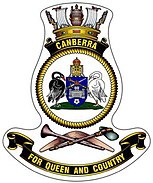HMAS Canberra (L02)

Canberra arriving at Pearl Harbor for RIMPAC 2016
|
|
| History | |
|---|---|
|
|
|
| Namesake: | City of Canberra |
| Builder: | Navantia, Ferrol, Spain and BAE Systems Australia, Williamstown, Victoria |
| Laid down: | 23 September 2009 |
| Launched: | 17 February 2011 |
| Commissioned: | 28 November 2014 |
| Homeport: | Fleet Base East |
| Motto: | For Queen and Country |
| Honours and awards: |
Battle honours: five inherited battle honours |
| Status: | Active as of 2016 |
| Badge: |  |
| General characteristics | |
| Class and type: | Canberra-class Landing Helicopter Dock |
| Displacement: | 27,500 tonnes (30,300 short tons; 27,100 long tons) at full load |
| Length: | 230.82 m (757.3 ft) |
| Beam: | 32.0 m (105.0 ft) |
| Draft: | 7.08 m (23.2 ft) |
| Propulsion: |
|
| Speed: |
|
| Range: | 9,000 nautical miles (17,000 km; 10,000 mi) at 15 knots (28 km/h; 17 mph) |
| Boats & landing craft carried: |
4 × LLC |
| Capacity: |
|
| Troops: | 1,046 |
| Complement: | 358 personnel; 293 RAN, 62 Australian Army, 3 RAAF |
| Sensors and processing systems: |
Giraffe AMB radar, Saab 9LV combat system |
| Electronic warfare & decoys: |
|
| Armament: |
|
| Aircraft carried: |
|
| Aviation facilities: | Flight deck with 13 degree ski-jump, 6 in-line deck landing spots |
HMAS Canberra (L02) is the first of two Canberra-class landing helicopter dock (LHD) ships constructed for the Royal Australian Navy (RAN). Construction of the ship started in Spain in 2008, with the hull launched by Navantia in 2011. The hull was then transported to Australia in late 2012 for completion by BAE Systems Australia. Canberra was commissioned on 28 November 2014.
The Canberra class design is based on the warship Juan Carlos I, built by Navantia for the Spanish Navy. The contract was awarded to Navantia and Australian company Tenix Defence following a request for tender which ran from February 2004 to June 2007, beating the enlarged Mistral class design offered by French company Direction des Constructions Navales.Canberra has the same physical dimensions as Juan Carlos I, but differs in the design of the island superstructure and the internal layout, in order to meet Australian conditions and requirements. Unlike the Spanish vessel, the Australian ships are built to meet Lloyd's Naval Rules.
The Canberra-class vessels are 230.82 metres (757.3 ft) long overall, with a maximum beam of 32 metres (105 ft), and a maximum draught of 7.08 metres (23.2 ft). At full load, Canberra will displace 27,500 tonnes (27,100 long tons; 30,300 short tons), making her the largest vessel to serve in the RAN. Propulsion is provided by two Siemens 11-megawatt (15,000 hp) azimuth thrusters, each with an onboard electric motor, driving two 4.5-metre (15 ft) diameter propellers. The electricity is provided by a Combined diesel electric and gas system, with a single General Electric CM2500 gas turbine producing 19,160 kilowatts (25,690 hp), supported by two MAN 16V32/40 diesel generators, each providing 7,448 kilowatts (9,988 hp). Maximum speed is over 20 knots (37 km/h; 23 mph), with a maximum sustainable full-load speed of 19 knots (35 km/h; 22 mph), and an economical cruising speed of 15 knots (28 km/h; 17 mph). Economical range is 9,000 nautical miles (17,000 km; 10,000 mi).
...
Wikipedia
